Salinity Management Guide
Problems involving turfgrasses
Plant damage resulting from salt-affected soils and saline waters
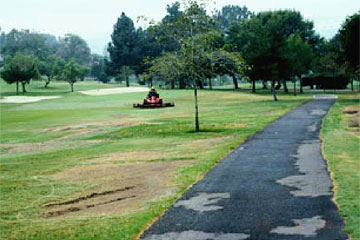
Photo courtesy of Stowell and Gelernter. |
Symptoms: Kikuyu grass irrigated with recycled water, showing signs of damage. Diagnosis: Excess salinity in water. Solution: The fairway was replanted with more salt-tolerant paspalum variety, and is now thriving. |
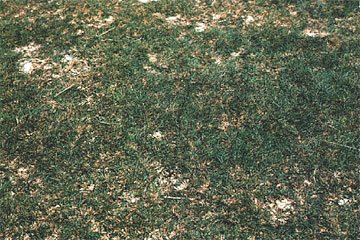
Photo courtesy of Ali Harivandi. |
Symptoms: Turfgrass not surviving well (spotty). Visible accumulation of salt on the surface of the soil. Diagnosis: Salt damage. Solutions: Leach salt from the soil by irrigating with low-salt water (provided internal drainage is adequate). Replant with salt-tolerant grasses, such as Bermudagrass, alkaligrass, or seashore paspalum. |
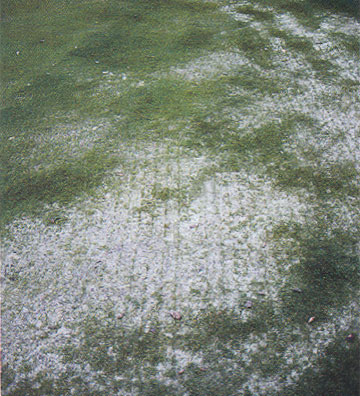
Photo courtesy of Carrow and Duncan. |
Symptoms: Poor survival of seedlings. Diagnosis: Soil is salt-affected. Solutions: Leach soil with adequate drainage before replanting with a more salt-tolerant species, such as Bermudagrass or paspalum. |
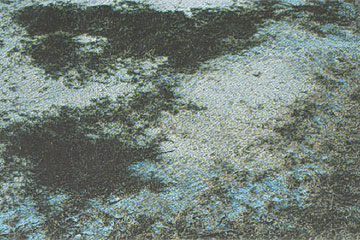
Photo courtesy of Carrow and Duncan. |
Symptoms: Seashore paspalum heavily damaged by white-to-gray salt deposits. Diagnosis: Excess salinity and waterlogging. Paspalum is one of the more salt tolerant turfgrass species. Solutions: The opportunities to reclaim the soil and re-establish paspalum or Bermudagrass appear to be quite limited, because the problem described is very severe. |
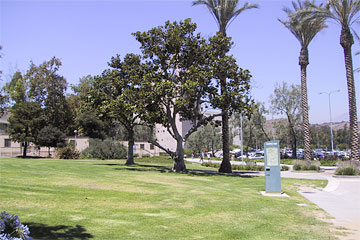
Photo courtesy of Ken Tanji. |
Symptoms: This landscape at California State Polytechnic University, Pomona, has been irrigated with recycled water for decades. The lawn appears to suffer from scalping or scalding during the summer. Diagnosis: An adjacent lawn does not show these symptoms. Diagnosis is inconclusive: cannot determine whether the problem is due to abiotic or biotic causes. Solutions: Avoid overwatering, since the scalping or scalding occurs mainly during the summer months. |
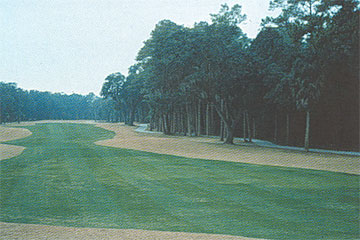
Photo courtesy of Carrow and Duncan. |
Symptoms: Over-seeded turfgrass exhibits yellowing during the winter months. Diagnosis: Mild salinity stress. Solutions: Leach turf of excess salinity prior to winter months. |
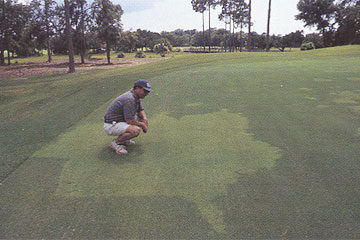
Photo courtesy of Carrow and Duncan. |
Symptoms: A native Seashore paspalum (dark green) is taking over a Tifgreen Bermudagrass green (light green) on this site along a seashore. Diagnosis: The paspalum species is more salt-tolerant than the Bermudagrass. Solutions: Leaching may reduce invasion of paspalum. If not, allow it to take over the Bermudagrass. |
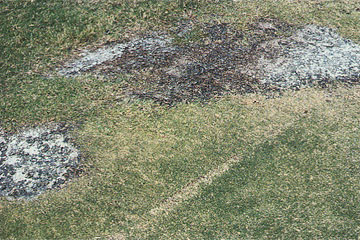
Photo courtesy of Carrow and Duncan. |
Symptoms: Intermittent but relatively severe damage from white and black salts. Diagnosis: Soil water from this site has an ECe of 26 to 85 dS/m and a SAR of 32 to 67. Thus, the soil is both saline and sodic. Solutions: Reclaim the salt-affected soil by leaching, applying calcium amendments, and providing adequate drainage. Replant as necessary with salt-tolerant species, such as seashore paspalum, alkaligrass, or Bermudagrass. |
| « Previous page | Next page » |